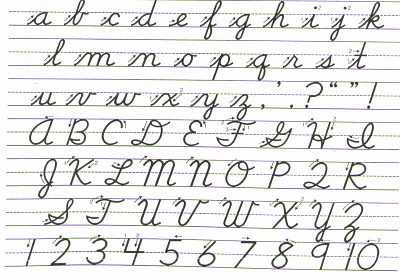My aunt, an English professor, recently shared a story with me about one of her students. Her student, a college freshman, approached her to talk about a paper he recently turned in. When she asked if he had a question about a specific comment that she had written on his paper, his response was, "Well, I can't read what you wrote. I can't read cursive."
Whoa.
My aunt was shocked. As an OT, I was surprised, but not shocked. I've spent a lot of time in elementary classrooms, and I know that many students are no longer being taught cursive. In fact, many students are not even being properly taught how to print! [
side note - I'd like to point out that this is at no fault of the teachers and this issue probably requires its own blog post]
Is cursive dead?
The New York Times recently ran a Room for Debate column on
Is Cursive Dead? The lovely folks over at
PediaStaff were kind enough to bring this article to my attention and asked if I cared to weigh in on the discussion.
Okay, okay. So I've seen first hand that cursive is not being taught in schools. But what is my opinion on the demise of cursive? The big question here is:
Should schools require children to learn cursive?
In my opinion, no.
I learned to write in cursive in third grade. And I loved it! I thought it was fun. And so grown-up! And then, with the exception of a fifth grade teacher who required everything be written in cursive, I immediately stopped writing in cursive. Which means I have not regularly written in cursive since I was 10 years old. That was 20 years ago!
The times are changing, whether we like it or not, and it's time for our curriculum to reflect that.
Should students be exposed to cursive?
Yes.
Should students know how to read cursive?
Absolutely. After all, it's really not that different from print. Learn what the following 10 letters look like in cursive and you should be able to read cursive without too much difficulty: b, e, f, m, n, r, s, u, v, z.
Should students be able to sign their name in cursive?
Yes, even if it quickly turns into an illegible scribble unique to them, because that's all they need to be functional in this digital world.
Should students learn to write using paper and pencil?
Yes, but that doesn't mean it needs to be in cursive.
Should students learn how to effectively use technology for writing essays? For taking notes? For communicating?
Yes. Yes. And yes.
Cursive in the age of technology
So where
does cursive fit in in today's technological world? We still have to sign documents and receipts, even though many of those signatures are now done electronically. As an occupational therapist, I sign my name on reports, progress notes, daily notes, IEPs, etc. For most adults, there's really no way around the signature.
But, with the exception of my occasionally legible signature, I only write in cursive when I am helping a student learn to write their name in cursive.
Wait. Let's think about this for a minute. I only use cursive when I'm teaching students how to write in cursive. After all that I've written above, when do I expect that they will
ever use cursive in their lives?
The answer is, I don't expect students today to ever use cursive. But as an occupational therapist, I want my students to be functional and independent, which I believe does include a cursive signature. After reading
this article from NPR about the fading away of the signature, I'm beginning to question the relevance of a signature in today's world. Maybe the merit of a signature will come up in a future Room for Debate :-)
Some final food for thought for OTs and educators.
Why are we so insistent that students learn cursive? Is cursive
really the best option for certain students with learning disabilities, such as dyslexia? If so, where is the research to support it? Where are the studies that provide evidence of the benefits of cursive writing on brain development?
Are we holding onto cursive purely because of nostalgia?
Does a legible signature even matter these days?
To hear more thoughts on cursive in this era of technology, check out
PediaStaff's roundup of posts written by occupational therapists in response to the Room for Debate article!
Please weigh in with your thoughts on this conversation in the comments below. I would love to see this conversation continue.


